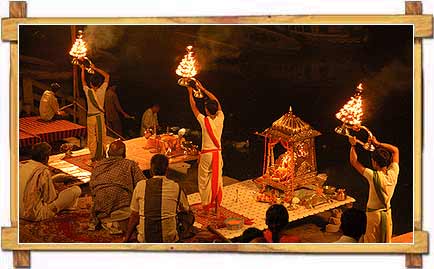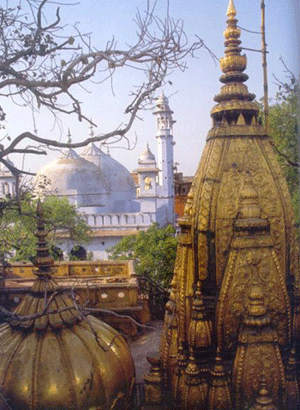1) Varanasi Ghats: The ghats on the banks of the river Ganges are the soul of Varanasi. The ghats are virtually the kaleidoscope of belief, customs and traditions that constitute the philiosphy that is Varanasi. There are 84 ghats in number – huge rectangular stairs that lead to the river edge. Some of them were built as early as the 12 century while others have a more recent origin..
2) Kashi Vishwanath Temple: Originally built in 1776 by Maharani Ahilya Devi of Indore, the towers of the temple were gold plated by the Maharaja Ranjit Singh in 1835 who donated 1000 kg of gold. The ‘shivalinga’ in the temple 60 cm tall and 90 cm in circumference housed in a silver altar.
3) St. Mary’s Church: St. Mary’s is probably the oldest Protestant Church in North India outside Calcutta. The foundation stone was laid on 29th April 1810 by Daniel Corrie. This beautiful Church is situated in 11.25 acres of land and has historic background which will be seen from the monuments in the campus of British soldiers who died in action. St Mary"s Church is situated in the cantonment area of Varanasi. This church has a low tower, spire and projecting portico. There are three simple louvered doors beneath plain cornices alternating with two bays, each with white plaster niches. Above each doorway is a rectangular fanlight, protected from the glare of the sun by a plain timber canopy - a simple device which has a major architectural impact.
4) Manikarnika Ghat: Also known as the “Mahashamsana’ or the ‘ Great Cremation Ground of the World’, Manikarnika ghat is where dead are brought from all over the country to be cremated by fire. There is a ‘sacred fire’ that has been burning since centuries and it is the fire from this that is used for the cremation. It is believed that those who are cremated at Manikarnika ghat attain moksha and their souls are set free from the endless cycle of birth and death.
5) Bharat Kala Bhavan: An archaeological museum built in the campus of the Banaras Hindu University. Established in 1920, the museum has vast collection of over 100,000 artifacts like paintings, textiles, costumes, decorative arts, Indian philately and literary and archival materials. The first floor has Numismatic Gallery (collection of coins), Archaeological Gallery, Decorative Art Gallery, Benaras Through the Ages Gallery and Galleries on Alice Boner and M. K. Gupta. There are some proposed extensions of galleries like the Gallery of Archive and Literary Materials, Gallery on Textiles and Costumes and a Gallery of Metal Images.
6) Ramnagar Fort : This fort-palace was built in the eighteenth century and is the home of the king of Kashi( or Varanasi). Built in red sandstone, the fort has a museum displaying the Royal collection which includes vintage Cars, Royal palkies, an armory of swords and old guns, ivory work and antique clocks. Also, on display are ornate palanquins, gold-plated howdahs and weapons.
7) Chunar Fort: Built by Maharaja Vikramaditya, the king of Ujjain(in Madhyapradesh), this fort had been the stronghold of Babar followed by Shershah Suri, Humayun, Akbar, Aurangzeb and finally,’ the Britishers. Chunar fort is constructed at a height of 80’ to 175’ from the land level of Chunar. The fort area is approx. 3400 Sq. yard, its length is 800 yard & width is 133 to 300 yard. The Chunar Fort is located at a distance of 42 kilometers fron Varanasi city. Worth seeing inside the fort are the Sonva Mandap, Raja Bhartihari Samadhi, Bavan Khamba & Solar Watch.
8) Sarnath : A small town barely 12 kms from Varanasi rail junction, Sarnath is one of the most important Buddhist pilgrimage and heritage site. This is where the Lord Buddha delivered his first sermon. Sarnath is home to the excavated remains of the ancient Buddhist monasteries, the famous Lion capital – India’s national emblem, a archaeological museum, huge stupas including the Dhamek and Chaukhandi Stupa and many Buddhist temples built here by missions from Japan, China, Tibet, Cambodia and others.
9) Nepali Temple: This unique temple is situated on the Lalita Ghat on the bank of the river Ganges. The temple was commissioned by the King of Nepal and is built in the Nepali style of architecture by workers who were brought from Nepal to create this marvel. The wood used in the temple is also found in Nepal. The specialty of the wood used in the temple is that termites do not eat this wood. The temple features magnificent wood work and there are erotic wooden sculptures built in to the external columns and facades.Due to the erotic sculptures, it is also called ‘mini-khajuraho’. Another popular name for this temple is the ‘kaathwala’ temple.
10) Lakhania Dari Caves and Waterfall: Located at a distance of around 45 kms from Varanasi are the beautiful small hills of the Vindhyanchal mountain ranges. Ensconced in the hills is a mesmerizing waterfall that drains in to a small clear water lake. This is the Lakhania Dari. A small stream originates from the lake and huge boulders are strewn all over the two km long trek that leads to the waterfall from the lake. Ancient rock caves can be seen on the rocky face of the hills that surround the region. A visual treat for nature lovers and adventure seekers.
Subscribe to:
Post Comments (Atom)














Varanasi is also known as Kashi . It is on the banks of the sacred river Ganga . Its a religious place for all Hindu . Mansarovar Yatra
ReplyDelete